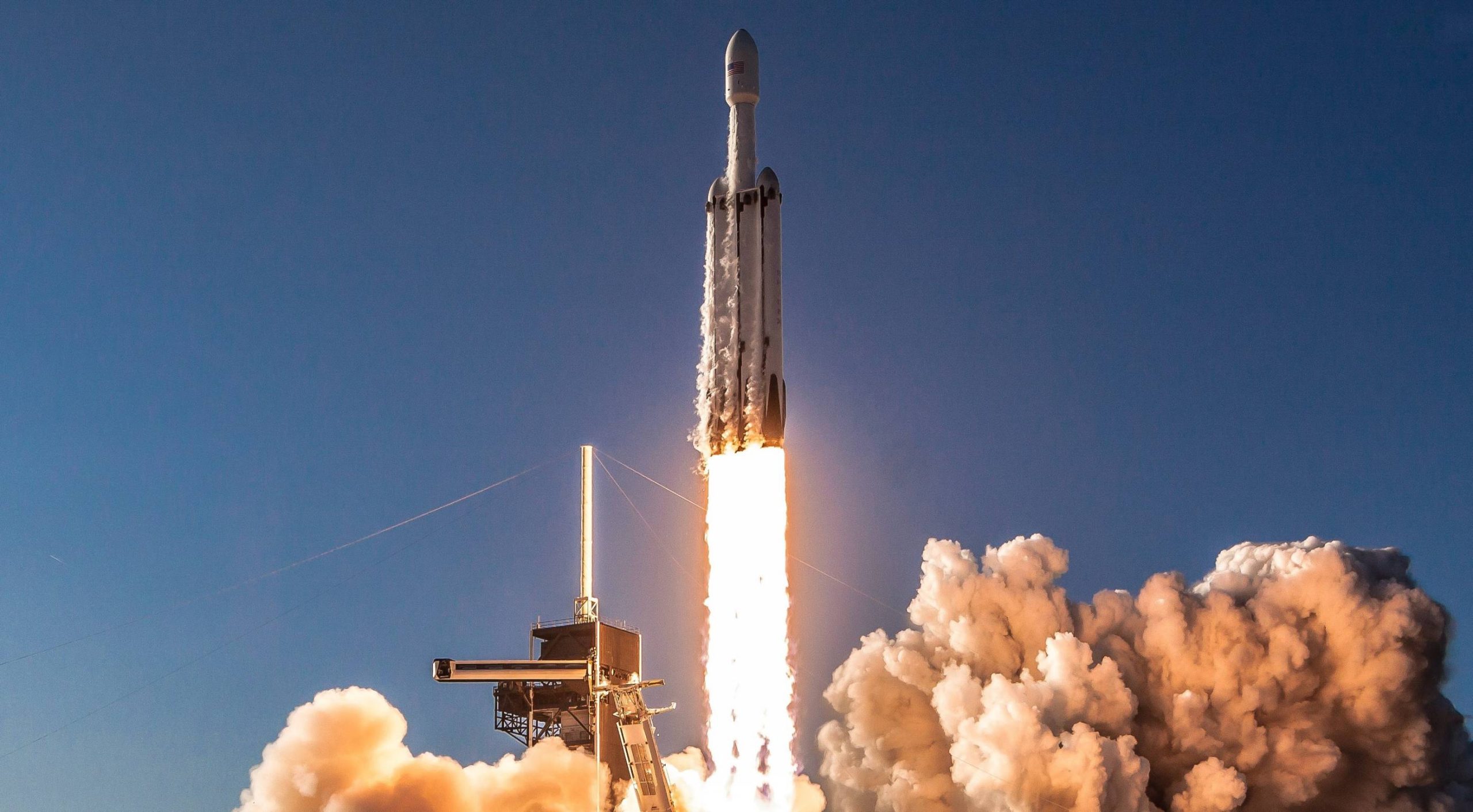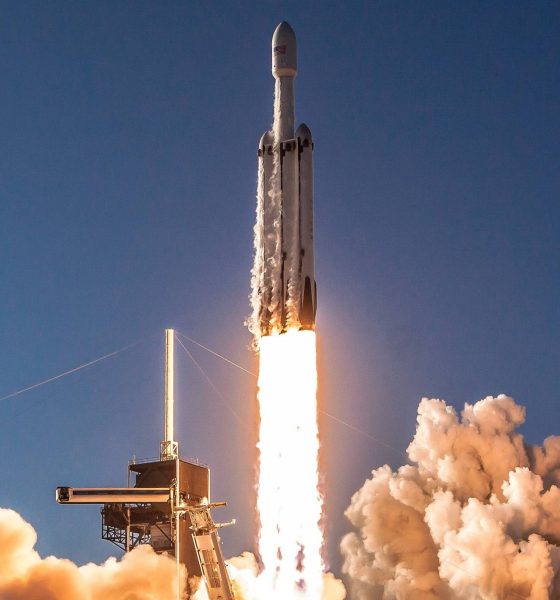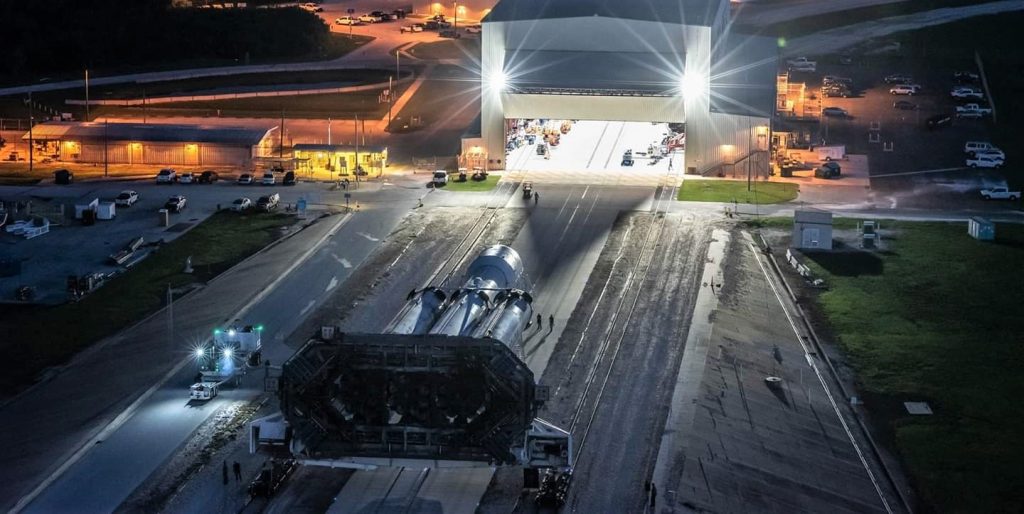

News
SpaceX schedules first Falcon Heavy launch in two years in early October
For the first time in more than two years, SpaceX has a firm launch date for its next Falcon Heavy mission: October 9th, 2021.
Revealed on September 7th as part of a US Space Systems Command presentation at the 2021 Small Payload Ride Share Symposium, October 9th now appears to be the military’s official target date for SpaceX’s fourth Falcon Heavy launch ever. Currently the most powerful and capable commercial rocket in operation and likely to remain so – perhaps alongside Starship – for years to come, Falcon Heavy debuted in February 2018, successfully delivering a mock payload into interplanetary space.
After another 14 months of work, SpaceX then debuted Falcon Heavy Block 5 – an upgraded version of the rocket that took advantage of all of Block 5’s reusability, reliability, and performance improvements. Just two months after Falcon Heavy Block 5’s inaugural April 2019 launch, SpaceX launched the rocket for the third time, supporting a US Air Force rideshare mission, reusing both of Flight 2’s side boosters, and giving the US military a firsthand demonstration of the rocket’s capabilities. However, Falcon Heavy has not flown once since then.
For mostly unknown reasons, Falcon Heavy’s fourth launch – a US military mission known as USSF-44 (formerly AFSPC-44) – has gradually slipped from a late-2020 target to Q1, Q2, Q3, and finally Q4 (October) 2021. SpaceX only began qualifying USSF-44’s Falcon Heavy boosters at its McGregor, Texas test facilities in late September 2020, a few weeks after delays from late-2020 to February 2021 and June 2021 were quietly announced. At that point, the US was deep into the throes of the COVID-19 pandemic’s local peak.
Only in May 2021 did the US military finally directly address major USSF-44 and USSF-52 delays, blaming them on “payload readiness.” Given that the Space Force never blamed SpaceX or rocket availability for what is likely to be a full year of launch delays, the implication is that likely satellite manufacturers Northrop Grumman, Lockheed Martin, Maxar, or Boeing have run into major technical issues. It’s also possible that those payload-side delays have been caused by a combination of supply chain issues and constraints brought on by the ongoing global pandemic.
Meanwhile, USSF-44’s all-new Falcon Heavy rocket appears to have been at Cape Canaveral and more or less ready for flight since Q2 2021 and SpaceX has been hard at work qualifying at least two more Falcon Heavy center cores for at least two additional missions scheduled in H1 2022.
Scheduled to launch no earlier than (NET) October 9th, Falcon Heavy #4 will likely roll out to Kennedy Space Center Pad 39A around 5-7 days prior for a crucial static fire test and pad shakedown. SpaceX is currently scheduled to launch Crew Dragon’s all-private Inspiration4 mission as early as September 14th, giving the company around three weeks to modify Pad 39A and its transporter/erector, gather all four USSF-44 Falcon Heavy stages, and assemble the rocket. Another Crew Dragon mission is then scheduled to launch as early as October 31st, again leaving SpaceX less than three weeks to reconfigure Pad 39A.
Successfully completing that back-to-back-to-back Dragon-FH-Dragon manifest on schedule will be a significant challenge and delays are probably more likely than not. Nevertheless, Falcon Heavy will likely roll out to the launch pad for the first time in more than two years less than a month from today.


News
Tesla FSD fleet is nearing 7 billion total miles, including 2.5 billion city miles
As can be seen on Tesla’s official FSD webpage, vehicles equipped with the system have now navigated over 6.99 billion miles.

Tesla’s Full Self-Driving (Supervised) fleet is closing in on almost 7 billion total miles driven, as per data posted by the company on its official FSD webpage.
These figures hint at the massive scale of data fueling Tesla’s rapid FSD improvements, which have been quite notable as of late.
FSD mileage milestones
As can be seen on Tesla’s official FSD webpage, vehicles equipped with the system have now navigated over 6.99 billion miles. Tesla owner and avid FSD tester Whole Mars Catalog also shared a screenshot indicating that from the nearly 7 billion miles traveled by the FSD fleet, more than 2.5 billion miles were driven inside cities.
City miles are particularly valuable for complex urban scenarios like unprotected turns, pedestrian interactions, and traffic lights. This is also the difference-maker for FSD, as only complex solutions, such as Waymo’s self-driving taxis, operate similarly on inner-city streets. And even then, incidents such as the San Francisco blackouts have proven challenging for sensor-rich vehicles like Waymos.
Tesla’s data edge
Tesla has a number of advantages in the autonomous vehicle sector, one of which is the size of its fleet and the number of vehicles training FSD on real-world roads. Tesla’s nearly 7 billion FSD miles then allow the company to roll out updates that make its vehicles behave like they are being driven by experienced drivers, even if they are operating on their own.
So notable are Tesla’s improvements to FSD that NVIDIA Director of Robotics Jim Fan, after experiencing FSD v14, noted that the system is the first AI that passes what he described as a “Physical Turing Test.”
“Despite knowing exactly how robot learning works, I still find it magical watching the steering wheel turn by itself. First it feels surreal, next it becomes routine. Then, like the smartphone, taking it away actively hurts. This is how humanity gets rewired and glued to god-like technologies,” Fan wrote in a post on X.
News
Tesla starts showing how FSD will change lives in Europe
Local officials tested the system on narrow country roads and were impressed by FSD’s smooth, human-like driving, with some calling the service a game-changer for everyday life in areas that are far from urban centers.

Tesla has launched Europe’s first public shuttle service using Full Self-Driving (Supervised) in the rural Eifelkreis Bitburg-Prüm region of Germany, demonstrating how the technology can restore independence and mobility for people who struggle with limited transport options.
Local officials tested the system on narrow country roads and were impressed by FSD’s smooth, human-like driving, with some calling the service a game-changer for everyday life in areas that are far from urban centers.
Officials see real impact on rural residents
Arzfeld Mayor Johannes Kuhl and District Administrator Andreas Kruppert personally tested the Tesla shuttle service. This allowed them to see just how well FSD navigated winding lanes and rural roads confidently. Kruppert said, “Autonomous driving sounds like science fiction to many, but we simply see here that it works totally well in rural regions too.” Kuhl, for his part, also noted that FSD “feels like a very experienced driver.”
The pilot complements the area’s “Citizen Bus” program, which provides on-demand rides for elderly residents who can no longer drive themselves. Tesla Europe shared a video of a demonstration of the service, highlighting how FSD gives people their freedom back, even in places where public transport is not as prevalent.
What the Ministry for Economic Affairs and Transport says
Rhineland-Palatinate’s Minister Daniela Schmitt supported the project, praising the collaboration that made this “first of its kind in Europe” possible. As per the ministry, the rural rollout for the service shows FSD’s potential beyond major cities, and it delivers tangible benefits like grocery runs, doctor visits, and social connections for isolated residents.
“Reliable and flexible mobility is especially vital in rural areas. With the launch of a shuttle service using self-driving vehicles (FSD supervised) by Tesla in the Eifelkreis Bitburg-Prüm, an innovative pilot project is now getting underway that complements local community bus services. It is the first project of its kind in Europe.
“The result is a real gain for rural mobility: greater accessibility, more flexibility and tangible benefits for everyday life. A strong signal for innovation, cooperation and future-oriented mobility beyond urban centers,” the ministry wrote in a LinkedIn post.
News
Tesla China quietly posts Robotaxi-related job listing
Tesla China is currently seeking a Low Voltage Electrical Engineer to work on circuit board design for the company’s autonomous vehicles.

Tesla has posted a new job listing in Shanghai explicitly tied to its Robotaxi program, fueling speculation that the company is preparing to launch its dedicated autonomous ride-hailing service in China.
As noted in the listing, Tesla China is currently seeking a Low Voltage Electrical Engineer to work on circuit board design for the company’s autonomous vehicles.
Robotaxi-specific role
The listing, which was shared on social media platform X by industry watcher @tslaming, suggested that Tesla China is looking to fill the role urgently. The job listing itself specifically mentions that the person hired for the role will be working on the Low Voltage Hardware team, which would design the circuit boards that would serve as the nervous system of the Robotaxi.
Key tasks for the role, as indicated in the job listing, include collaboration with PCB layout, firmware, mechanical, program management, and validation teams, among other responsibilities. The role is based in Shanghai.
China Robotaxi launch
China represents a massive potential market for robotaxis, with its dense urban centers and supportive policies in select cities. Tesla has limited permission to roll out FSD in the country, though despite this, its vehicles have been hailed as among the best in the market when it comes to autonomous features. So far, at least, it appears that China supports Tesla’s FSD and Robotaxi rollout.
This was hinted at in November, when Tesla brought the Cybercab to the 8th China International Import Expo (CIIE) in Shanghai, marking the first time that the autonomous two-seater was brought to the Asia-Pacific region. The vehicle, despite not having a release date in China, received a significant amount of interest among the event’s attendees.








